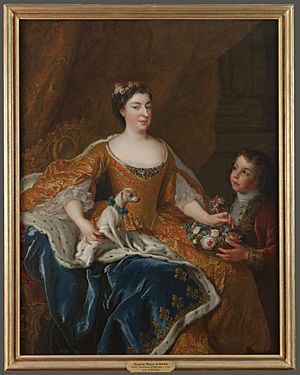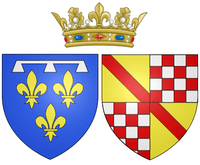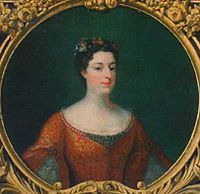Auguste of Baden-Baden facts for kids
Quick facts for kids Auguste of Baden-Baden |
|||||
|---|---|---|---|---|---|
| Duchess of Orléans | |||||
 |
|||||
| Born | 10 November 1704 Schloss Johannisburg, Bavaria |
||||
| Died | 8 August 1726 (aged 21) Palais-Royal, Paris, France |
||||
| Burial | 16 August 1726 Val-de-Grâce, Paris |
||||
| Spouse | Louis, Duke of Orléans | ||||
| Issue Detail |
|
||||
|
|||||
| House | House of Zähringen | ||||
| Father | Louis William of Baden-Baden | ||||
| Mother | Sibylle of Saxe-Lauenburg | ||||
| Religion | Roman Catholicism | ||||
| Signature | |||||
Auguste Marie Johanna of Baden-Baden (born November 10, 1704 – died August 8, 1726) was a princess from a German ruling family. She became the Duchess of Orléans when she married Louis, Duke of Orléans. Her husband was the grandson of the famous French king, Louis XIV of France. In France, she was known as Auguste de Bade. She passed away at a young age after giving birth to her second child. Auguste is an ancestor of many royal families in Europe today, including the Spanish and Italian royal families, and the current Grand Duke of Luxembourg.
Contents
Early Life
Auguste was born in Aschaffenburg. She was the ninth child of Louis William, a commander in the Holy Roman Empire's army. Her mother was Princess Sibylle of Saxe-Lauenburg. Sibylle was 20 years younger than Auguste's father.
When her father died in 1707, her mother Sibylle became the regent (ruler) of the Margraviate of Baden-Baden. This was a small state in Germany. She ruled for Auguste's older brother, Louis George, until he was old enough.
Auguste's mother loved art and architecture. She made Baden-Baden a place known for its beautiful buildings. During her time as regent (1707–1727), Sibylle had four palaces and two churches built. Auguste saw the building of the Schloss Favorite in Rastatt.
Auguste was the youngest of nine children. She was the only daughter who lived past the age of seven. She had two brothers who became rulers of Baden-Baden: Louis George (who ruled from 1702–1761) and Augustus George (who ruled from 1761–1771).
Duchess of Orléans
Since her mother was the ruler of Baden-Baden, she was in charge of finding a good husband for Auguste. Her mother suggested two choices. One was Prince Alexander Ferdinand of Thurn and Taxis. He was from a very rich German noble family. The other was a French prince, Louis, Duke of Orléans.
Auguste's mother preferred the French prince. This marriage would help make her state stronger with France, a powerful neighbor. France had caused a lot of trouble for Baden-Baden before Auguste was born. Auguste, however, liked the German prince more because of her German background.
But Auguste agreed to her mother's choice. She married Louis, Duke of Orléans, in a special ceremony at the Schloss Rastatt. This was a proxy ceremony, meaning someone stood in for Louis. The actual marriage took place on July 13, 1724. Louis was the grandson of King Louis XIV of France. Auguste was chosen partly because her family was Catholic. She brought a relatively small dowry (money or goods given by the bride's family) of 80,000 French livres (an old French currency).
At the French court in Versailles, Auguste was known as Jeanne or Auguste de Bade. She signed her name as Auguste de Bade. Her marriage to the First Prince of the Blood (a very important royal title) allowed her to use the title Madame la Princesse. This made her one of the most important ladies at the court of the young King Louis XV of France.
When she married, King Louis XV was "engaged" to his cousin, the Infanta Mariana Victoria of Spain. They never actually married. In 1725, the Infanta was sent back to Spain. This made Auguste and her mother-in-law, the Dowager Duchess of Orléans, the most important women at court. Auguste was well-liked by everyone at court and was known for being very charming.
In 1725, Louis XV married Marie Leszczyńska. This made Auguste one step below the new queen in terms of rank. Auguste and her husband lived in the Château de Saint-Cloud, one of the Orléans family homes. They also had an apartment at the Château de Versailles, where their son Louis Philippe was born in 1725.
In August 1726, Auguste was expecting her second child. Her mother-in-law insisted she return to Paris to have the baby at the Palais-Royal. Auguste left Versailles on August 4 but had to stop in Sèvres because her labor pains were so strong. Despite the stop, she made it back to Paris.
Auguste died on August 8, 1726, at the age of 21. This was three days after giving birth to her second child at the Palais-Royal. Even though their marriage was short, many people at the time said that Auguste and Louis were a perfect match. They believed the couple fell in love right away. After her death, her husband was very sad for a long time. People said that Auguste "had all the great qualities of the heart" and that "she died with the universal regret of France."
She was buried at the Val-de-Grâce Convent in Paris. After her death, her husband's aunt, Élisabeth Charlotte d'Orléans, suggested Louis marry one of her daughters. But Louis refused to marry again.
Issue
- Louis Philippe d'Orléans (born May 12, 1725 – died November 18, 1785). He married Louise Henriette de Bourbon and had children.
- Louise Marie d'Orléans (born August 5, 1726 – died May 14, 1728). She passed away when she was very young.
See also
 In Spanish: Augusta de Baden-Baden para niños
In Spanish: Augusta de Baden-Baden para niños



